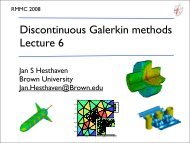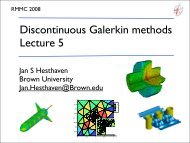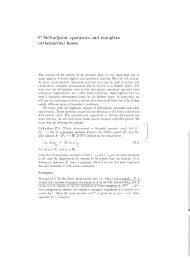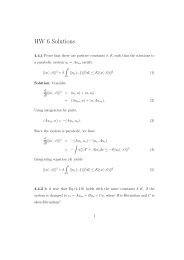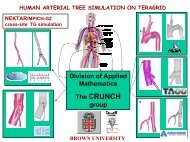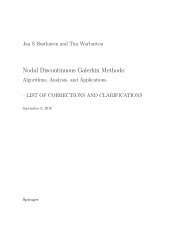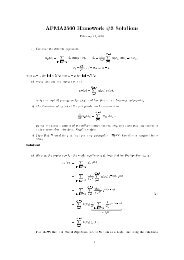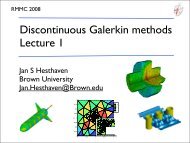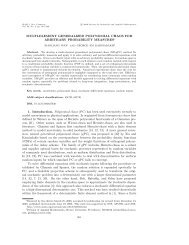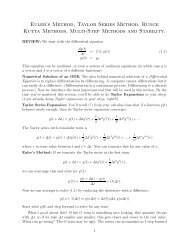Discontinuous Galerkin methods Lecture 3 - Brown University
Discontinuous Galerkin methods Lecture 3 - Brown University
Discontinuous Galerkin methods Lecture 3 - Brown University
Create successful ePaper yourself
Turn your PDF publications into a flip-book with our unique Google optimized e-Paper software.
imating polynomial of order N. Hence, the Lebesque constant indicates h<br />
o appreciate how this relates to the conditioning of V, recognize t<br />
Since we have already determined that<br />
Local approximation<br />
˜ Pn is the optimal<br />
Np with the need to choose the grid points ξi to define the Vand<br />
u(r) uh(r) = ûn There is significant freedom in this choice, so let us try to<br />
n=1<br />
intuition for a reasonable criteria.<br />
We first recognize that if<br />
˜ re · ∞ is the usual maximum norm and u<br />
Pn−1(r),<br />
olant (i.e., u(ξi) =uh(ξi) at the grid points, ξi), then we can write<br />
∗ far away the interpolation may be from the best<br />
represents<br />
possible<br />
the<br />
polynomial<br />
best appr<br />
rep<br />
tingsentation polynomial u of order N. Hence, the Lebesque constant indicates h<br />
away the interpolation may be from the best possible polynomial rep<br />
∗ nsequence of uniqueness . Note that Λofisthe determined polynomial solelyinterpolation, by the grid points, we have ξi. To<br />
an optimal approximation, we should therefore aim to identify those poin<br />
Recall first that we have<br />
Np <br />
u(r) uh(r) = ûn<br />
n=1<br />
˜ ation u<br />
Np <br />
u(r) uh(r) = u(ξi)ℓi(r).<br />
Pn−1(r),<br />
i=1<br />
∗ ξi, that . Note minimize thatthe Λ is Lebesque determined constant. solely by the grid points, ξi. To<br />
optimalTo approximation, appreciate how we thisshould relates to therefore the conditioning aim to identify of V, recognize those that poi<br />
hat aminimize consequence theof Lebesque uniqueness constant. of the polynomial interpolation, we have<br />
To appreciate how this relates to the conditioning of V, recognize that<br />
V<br />
nsequence of uniqueness of the polynomial interpolation, we have<br />
T ℓ(r) = ˜ V<br />
P (r),<br />
T ℓ(r) = ˜ P (r),<br />
re ℓ =[ℓ1(r),...,ℓNp (r)]T and ˜ P (r) =[ ˜ P0(r),..., ˜ PN (r)] T and<br />
. We are<br />
d in the particular solution, ℓ, which minimizes the Lebesque const<br />
ecall Cramer’s rule for solving linear systems of equations<br />
This immediately implies<br />
is an interpolant (i.e., u(ξi) =uh(ξi) at the grid points, ξi),<br />
it as<br />
Np <br />
u(r) uh(r) = u(ξi)ℓi(r).<br />
where ℓ =[ℓ1(r),...,ℓNp (r)]T and ˜ P (r) =[ ˜ P0(r),..., ˜ PN (r)] T . We are int<br />
ested in the particular solution, ℓ, which minimizes the Lebesque constant<br />
V i=1<br />
T ℓ(r) = ˜ P (r),<br />
ℓi(r) = Det[VT (:, 1), VT (:, 2), . . . , ˜ P (r), VT (:,i+ 1),...,VT (:,Np)]<br />
or<br />
re ℓ =[ℓ1(r),...,ℓNp (r)]T and ˜ P (r) =[ ˜ P0(r),..., ˜ PN (r)] T . We are in<br />
d in the particular solution, ℓ, which minimizes the Lebesque constant<br />
recall Cramer’s rule for solving linear systems of equations<br />
ℓi(r) = Det[VT (:, 1), VT (:, 2), . . . , ˜ P (r), VT (:,i+ 1),...,VT (:,Np)]<br />
Det(VT we recall Cramer’s rule for solving linear systems of equations<br />
ℓi(r) =<br />
.<br />
)<br />
Det[VT (:, 1), VT (:, 2), . . . , ˜ P (r), VT (:,i+ 1),...,VT (:,Np)]<br />
Det(VT Det(V<br />
.<br />
)<br />
It suggests that it is reasonable to seek ξi such that the denominator (i.e.,<br />
determinant of V), is maximized.<br />
T )<br />
ggests that it is reasonable to seek ξi such that the denominator (i.<br />
rminant of V), is maximized.<br />
or this<br />
so we<br />
one<br />
should<br />
dimensional<br />
choose<br />
case,<br />
the<br />
the<br />
point<br />
solution<br />
to maximize<br />
to this problem<br />
the<br />
is know<br />
tively simple form as the Np zeros of [151, 159]<br />
determinant -- the solution is<br />
For this one dimensional case, the solution to this problem is known i<br />
relatively simple form as the Np zeros of [151, 159]<br />
zeros of<br />
f(r) = (1 − r 2 ) ˜ P ′ N (r).<br />
uggests that it is reasonable to seek ξi such that the denominator (i.e.,<br />
2 ˜′



